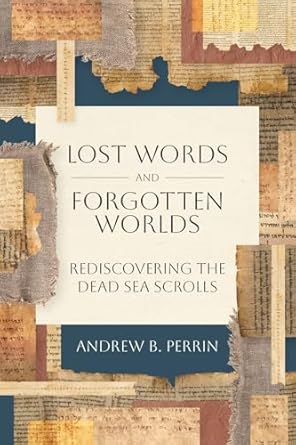A Brief Book Notice from Books At a Glance
It’s not every day we see a new – and helpful – book on the Dead Sea Scrolls, and this new resource is deserving of notice. Below is from the author’s Preface (pp. xiii-xv).
How to Read a Dead Sea Scroll
One of the exciting and frustrating things about the Dead Sea Scrolls (DSS) is that they are often tattered and torn manuscripts. At the best of times, they are nearly complete scrolls, but at the worst, they are Dead Sea scraps, deteriorated with age. This means the way texts are deciphered and represented is often confusing. This short guide will help you understand what text or composition you are reading, as well as why the text is referred to or presented in a certain way. Note that this guide strives for simplicity. There is some variety in how scholars or other publications might refer to the materials.
Names and Titles for Scrolls
Very few scrolls actually include the titles of the work on the scroll itself. In most cases, titles are assigned by modern editors. Many writings are attested in multiple manuscripts. When you come across something like 11QTempleScrolla or 11QTa, these are modern shorthand references for the Qumran Cave 11 copy of the Temple Scroll. Superscript letters indicate the first (a), second (b), third (c) copy, and so on, found in a particular cave. You may also come across a strictly numerical system for these references, which in this case would be 11Q19. In this book, when referring to the composition represented by one or more manuscripts, I will do so using its title in italics. In some cases, there is variety, disagreement, and multiple modern titles. In general, I pick or provide the ones that are most common or make the most sense. Confused yet? It’s not as tough as it sounds.
References to Content in Scrolls
Ancient scrolls are generally made up of several sheets of leather or papyrus. These were stitched together and then inscribed in columns. Scrolls can range from about the size of a cigarette butt to several meters in length. Unfortunately, in most cases, the DSS are in various states of decay. Whether scroll or scrap, the referencing system is essentially the same. When referring to a column or fragment number and line of text, I will do so by separating the two by a colon. Note that, like biblical verses, this numbering is not inherent to the texts; rather, it is a system developed to locate and refer to sections or lines. For example, 11Q19 52:1 refers to the fifty-second column and first line of the specific copy of 11Q19 or 11QTempleScrolla of the Temple Scroll. Works that are known only by puzzle pieces of fragments are also numbered, even if the structure in columns is not known. When the columns are known in fragmentary texts, they are referenced by Roman numerals after the manuscript and fragment number (for example 4Q542 1i: 4–7). For simplicity’s sake, in this book I will provide the manuscript number, column or fragment number, and line number when quoting or referencing a specific point in a DSS text. Don’t worry—you don’t need to look anything up. All the texts we work with will be right here in this book.
Transcriptions and Translations of the Scrolls
There are many places where the text of the DSS is lost or damaged, making it difficult to decipher. For original language transcriptions or English translations, any content that comes between square brackets is lost but reconstructed. Occasionally, I will include a word, phrase, or reference in regular brackets or parentheses. This content is to help smooth out translations or make clear for a modern reader when a biblical text is being cited but does not reflect the actual content of the scroll. Ellipses in translations indicate a larger stretch of damaged material. If it feels like some of the translations are glitchy sentence fragments strung together, that’s because in many instances they are. The word vacat is also included within transcriptions or translations to signify where scribes left an intentional blank space in between words in a paragraph.
I won’t quote the original language texts of the DSS (Hebrew, Aramaic, or Greek) very often in this book. When I do, I’ll always provide translations and make sense of what is going on in the original language texts. But there is also a system for reflecting the degrees of certainty of a given character. If a closed dot appears above a letter (א̇̇), this means it is probable. If a small open circlet appears above the letter (א̊), this means it is possible but not certain. If a big open circlet appears in line with the text (◦), this means there are remains of some lost letter but not enough to hazard a best guess. If there is no dot or circlet above the figure (א), the character is clear and uncontested.
That’s a bit about scroll texts and translations. Next up: where to find them.
